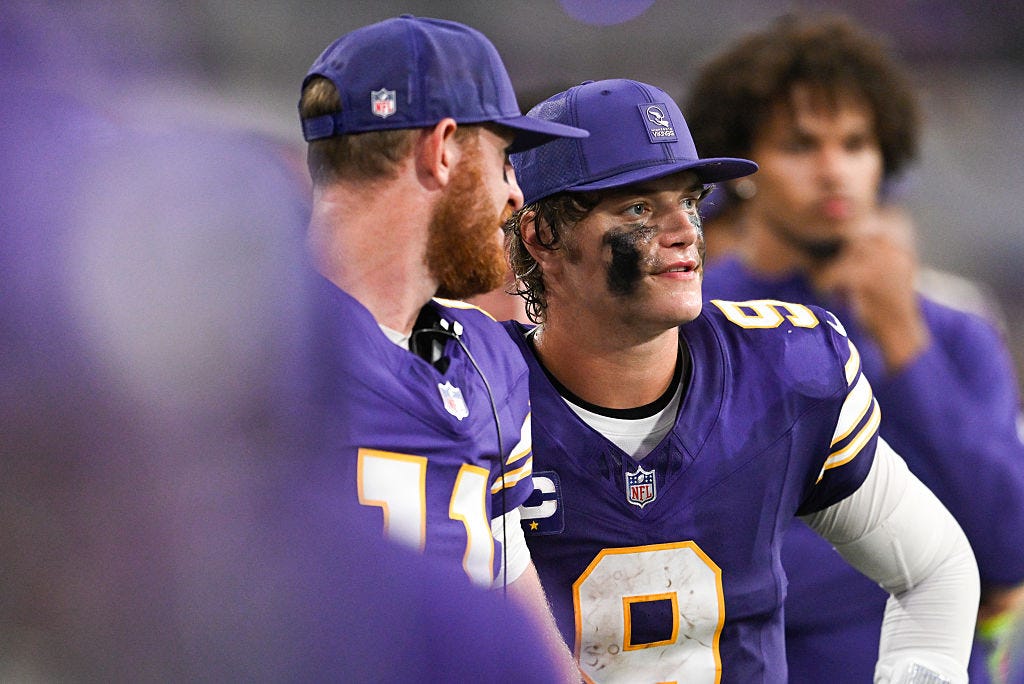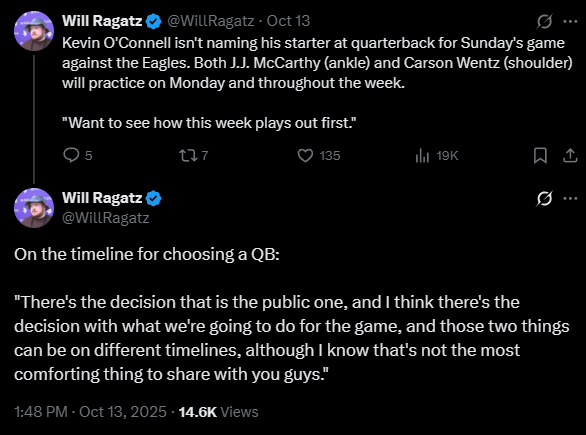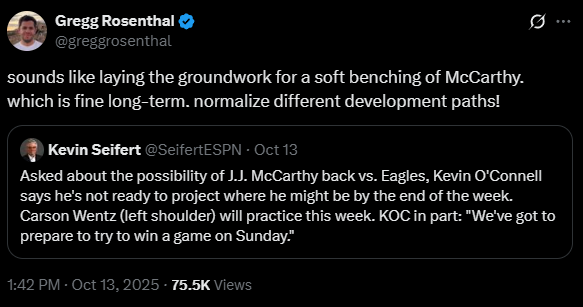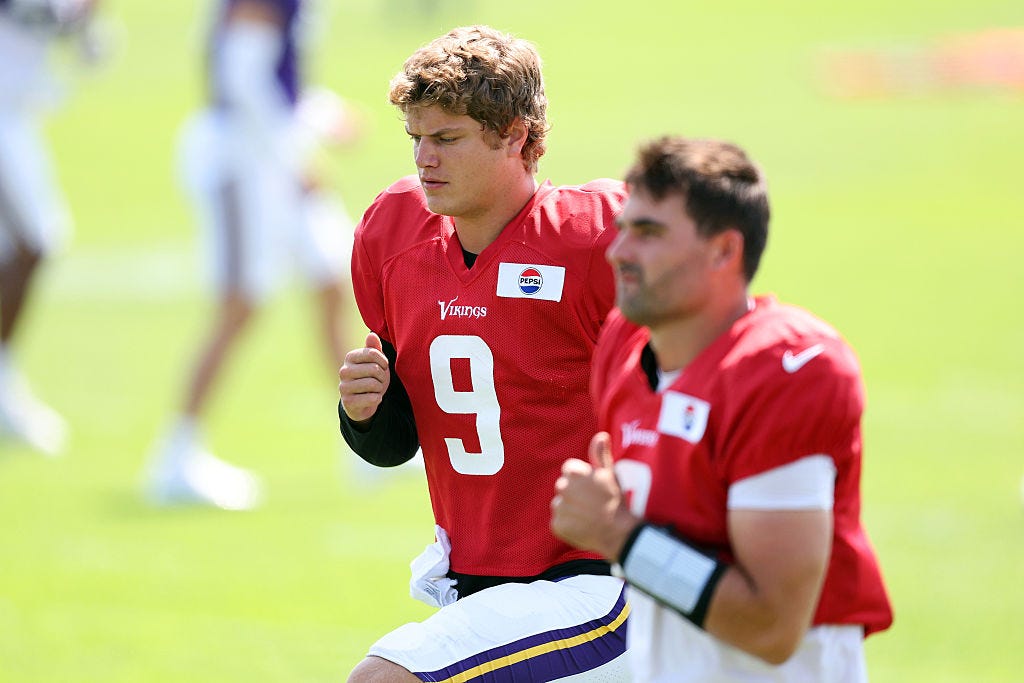Quarterback Controversy: Charting J.J. McCarthy and Carson Wentz to Find the Vikings Starter
Matt Fries dives deep into the film of both Vikings quarterbacks to figure out who's truly been playing better given their differing circumstances and what it means for who should start in Week 7
Now that the Minnesota Vikings have returned from their European trip and completed their bye week, one thing is on every Viking fan’s mind — who will start on Sunday against the Philadelphia Eagles, J.J. McCarthy or Carson Wentz?
Interpreting a Media Melange
During his Monday press conference, Vikings’ HC Kevin O’Connell was unwilling to answer that question, and expanded on that comment by implying that the team has either already made the decision or will make the decision soon, but not announce the choice to the public until later:
O’Connell has been consistent in his messaging surrounding the Vikings QB room, stating that McCarthy’s first step to returning as the Vikings starter is to get healthy from the high ankle sprain he suffered in Week 2 against the Atlanta Falcons.
Injuries, both to McCarthy’s ankle and Wentz’s shoulder, are clouding the picture. On one hand, it’s absolutely fair for O’Connell to hold off on announcing a starting QB until he’s had as much time as possible to evaluate both their respective recoveries.
After all, McCarthy is still potentially not fully healthy from his sprain. A high ankle sprain typically has a 4-6 week recovery timeline, and this is the 5th week since McCarthy sustained the injury. O’Connell added specifics when talking about McCarthy’s potential return on Monday, and referred to McCarthy’s ability to work on the footwork and mechanics that are the fundamentals of QB play:
On the other hand, O’Connell’s refusal to announce a starter opens room for speculation. While it’s true that a high ankle sprain typically carries a 4-6 week recovery time, it’s also true that other QBs have played through the injury, most notably Patrick Mahomes during the Kansas City Chiefs’ 2023 Super Bowl run.
Russell Wilson, in 2016, is the first memory I have of a QB playing through a high ankle sprain, but I’m sure there are many more examples [Ed. Note: Trevor Lawrence and Justin Herbert did this recently in the NFL, while Garrett Nussmeier and Quinn Ewers have done this recently in college].
So, while the public may understand that a skill position player — like CeeDee Lamb, who is also currently dealing with a high ankle sprain — will be out 4-6 weeks with a similar injury, other QBs have blown those expectations out of the water. The league’s best QBs have played through high ankle sprains. McCarthy isn’t playing through his. Thinking about it that way, one may ask the question — does this mean the Vikings think McCarthy isn’t good?
If you listen to the full press conference or even the video snippet above, you will clearly get the impression that O’Connell is excited about McCarthy, happy with his injury recovery, and is looking forward to McCarthy getting back to playing. When he starts will be contingent on McCarthy’s continued recovery, but O’Connell is clearly planning for McCarthy to start again.
There’s a problem, though. The NFL media landscape does not revolve around patching together multiple answers or dissecting tone throughout an entire press conference. Instead, it revolves around short clips or quotes posted to Twitter by beat reporters. That’s how you end up with takeaways like this:
Reactions like this create public doubt and indicate a potential issue with how O’Connell and the Vikings have handled McCarthy’s injury. By not being firm in naming McCarthy the team’s clear starter when healthy, any continued refusal to name a starter becomes evidence that McCarthy isn’t the starter. And, as QB is football’s most important position, O’Connell is going to get asked about it every time he steps up to the podium, so there are plenty of opportunities to build evidence.
Adding to the frustration is that we’ve already seen a similar story play out with McCarthy this year. The Vikings made offers to both Sam Darnold and Daniel Jones in free agency, but the big question surrounded Aaron Rodgers. Journalists reported, with great certainty, that Rodgers was interested in the Vikings and that the Vikings were reciprocating by considering the veteran quarterback.
In retrospect, it’s pretty clear that the Vikings were never serious about any of those options. If they’d wanted to, they could have signed Darnold to a contract similar to the 3 year, $100.5 million deal he got with Seattle, told Jones they wanted him to start and paid him enough to attract him back over the 1 year, $14.45 million deal he got from the Colts, or beaten the 1 year, $14.15 million deal Rodgers eventually got from the Steelers.
Despite that retrospective understanding, it was never clear in the moment exactly what the Vikings intended. At that time, the Vikings acknowledged conversations about Rodgers and didn’t close the book on signing him. Meanwhile, they turned down opportunities to name McCarthy the starter heading into training camp.
This situation feels much the same. It feels like the Vikings expect McCarthy to be their starter, but they’re not saying that directly. That leaves the door open for people to infer that they secretly plan on benching him based on individual quotes, like Gregg Rosenthal does above.
That’s not to lambast Rosenthal for a conclusion I think is incorrect. It’s not fair to ask a media personality who covers the NFL at large to watch every press conference every coach does and digest the context. Rosenthal isn’t even painting what he thinks is a benching in a negative light, referring to it as a “soft benching” meant to help McCarthy’s development as a quarterback.
It’s also not to criticize Kevin Seifert, the ESPN beat reporter for the Vikings, whose tweet Rosenthal is using as evidence. Seifert’s tweet is trying to answer the question “who will start at QB for the Vikings against the Eagles?” as well as he can in a character-limited format. Seifert also re-tweeted the video above, which the Vikings had posted to their official Twitter account, giving more context around McCarthy’s specific situation.
This situation exposes a problem with the current media environment. It’s very easy to go from a full press conference, to a shorter clip that includes context, to a single line quote, to a response to that quote that doesn’t consider the full context. From there, it gets picked up by aggregator accounts and posted alongside other opinions, with some AI slop probably thrown in for good measure.
At the end of the day, everyone talking about J.J. McCarthy, from O’Connell, to Rosenthal, to myself, has an incentive. It’s important to recognize what those incentives might be. O’Connell wants to prevent a gotcha moment from the press, and sidesteps answering direct questions about who will start in case something unforeseen changes.
Not to speak for Rosenthal, but from his tweet, I think he probably has a theory that intermittent time on the bench could be good for a young QB, and he’s probably in some way rooting for it to play out that way so he can talk about it on his popular podcast and hopefully increase his audience. I’m writing about this in part because it’s the most important topic surrounding the Vikings, and I want you to read this piece and also consider subscribing to Wide Left so Arif keeps paying me to write for him [Ed. Note: Pay???].
Obviously, that’s not the only reason I’m writing this, just like I’m confident a profit incentive isn’t the only reason Rosenthal provided an opinion on this situation. But it’s important to understand that the only person with an answer to the question, O’Connell, has made it clear that he’s not going to tell us right now, so anything you hear on the matter is speculation.
With that in mind, let’s try to answer the question the best way we can from the outside. We don’t have access to the Vikings meeting rooms and practice, but we do have access to the game tape. We can try to answer three questions: Who has played better between McCarthy and Wentz? How has the offense changed between the two quarterbacks? And who should start for the rest of the season? Let’s dive in.
Evaluating McCarthy vs. Wentz
McCarthy started two games and Wentz started three, so theoretically, we have a sample size to go off for each. But McCarthy actually has about half of the number of dropbacks that Wentz has, because the offense was on the field so little against the Bears and Falcons. Still, there’s enough to get an impression.
Statistically, it hasn’t been close, with Wentz producing at about the level of an average QB and McCarthy having the worst EPA/play in the NFL among QBs with 60 or more dropbacks, per rbsdm.com:
The stats look quite bad for McCarthy, but having studied both the Bears and the Falcons games in detail, I don’t think that’s exactly a fair characterization. It’s easy to parrot Cris Collinsworth on Sunday Night Football, saying McCarthy has played 8 quarters and 7 of them were bad, but that doesn’t tell the whole story.
By the same token, a solid EPA/play performance and a 2-1 record for Wentz doesn’t tell the whole story on his play either. To give each QB a full evaluation, I went through the tape and charted all of their plays.
I charted 64 plays, which includes designed runs and plays negated by penalty, for McCarthy and 127 plays for Wentz. This allowed me to come away with a bunch of interesting statistics on how each player was performing, as well as specific information on the way the Vikings’ offense was constructed differently with each quarterback.
Offensive Construction
It’s pretty clear that the Vikings have run a drastically different offense with Wentz than the one they were running with McCarthy. There are upsides and downsides to this, but let’s break down exactly what the differences are.
At his core, Kevin O’Connell wants a vertical passing attack, using play-action or the standard dropback game to get there. The Vikings have great vertical route runners in Justin Jefferson, Jordan Addison, and Jalen Nailor. O’Connell’s designs do a great job of getting Jefferson, who is the focal point for all opposing defenses, opportunities to make big plays down the field.
This structure showed up consistently throughout McCarthy’s reps. The Vikings used play-action on 22 plays, or 36.1% of McCarthy’s dropbacks. There was a significant dropoff for Wentz, who saw play-action called on 25.2% of his dropbacks, 32 plays. Passing concepts were also more complex with McCarthy, attacking downfield.
Keep reading with a 7-day free trial
Subscribe to Wide Left to keep reading this post and get 7 days of free access to the full post archives.








